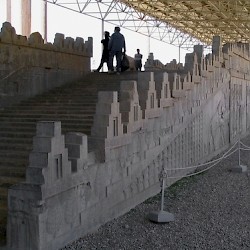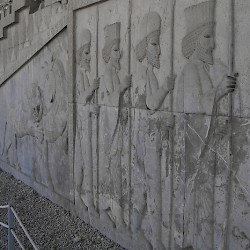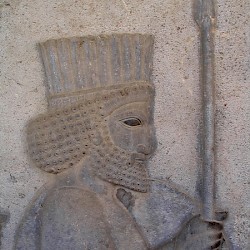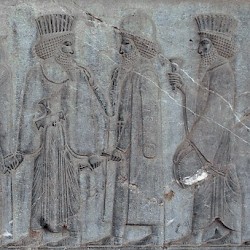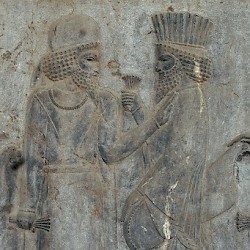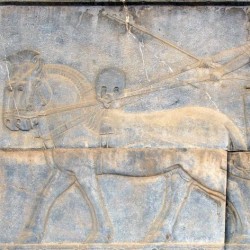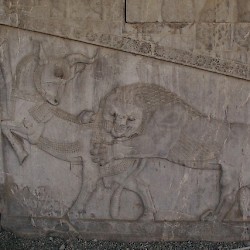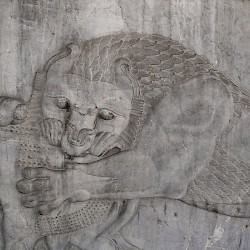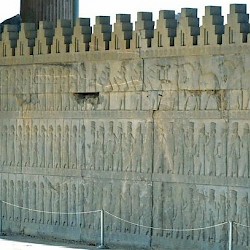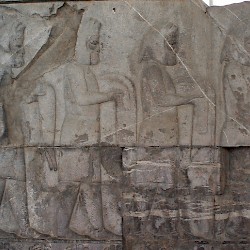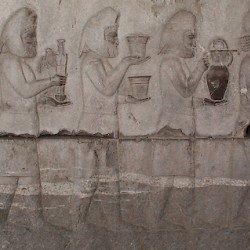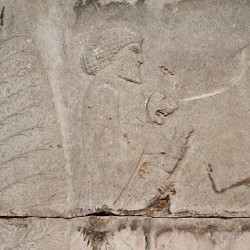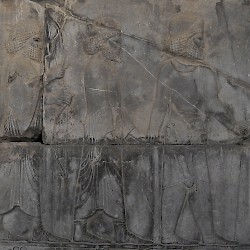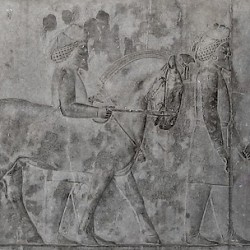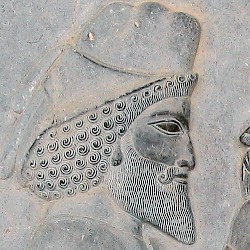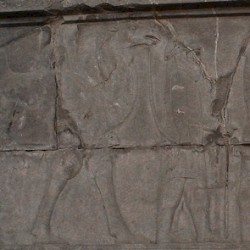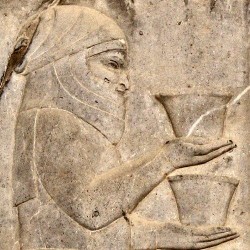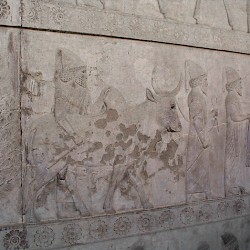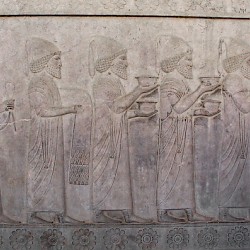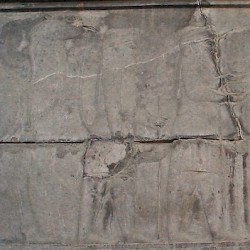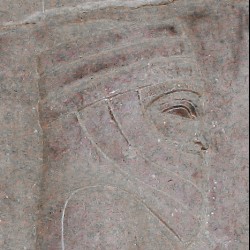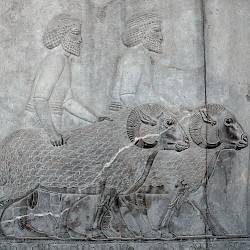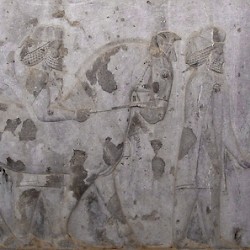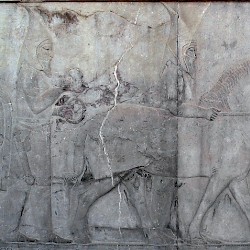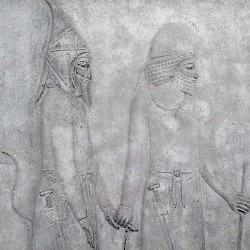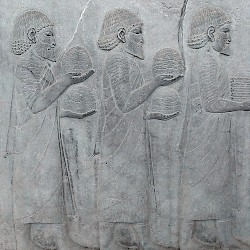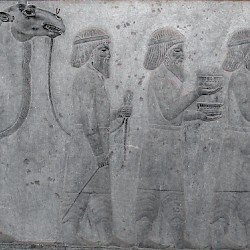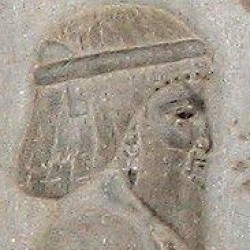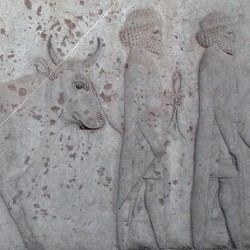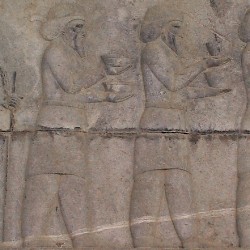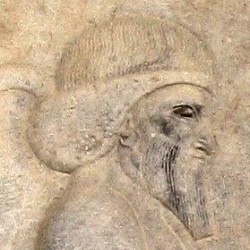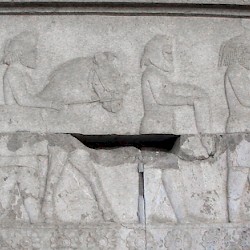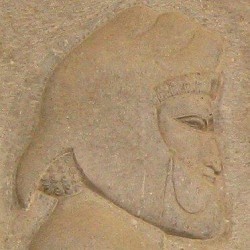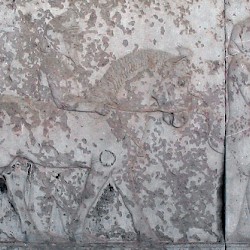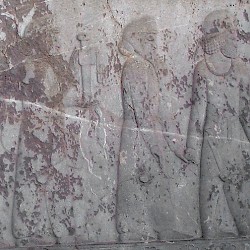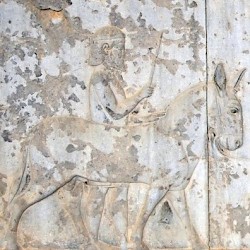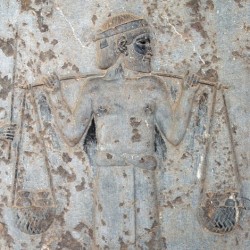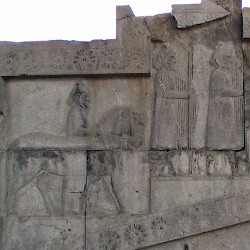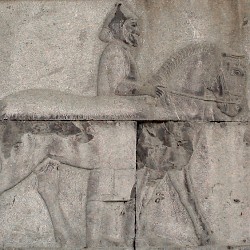Persepolis, Apadana, East Stairs
Q70786420Persepolis (Old Persian Pârsa, modern Takht-e Jamshid): Greek name of one of the capitals of the ancient Achaemenid Empire, founded by king Darius the Great (r.522-486 BCE). There were several satellite sites, Naqš-e Rustam and Takht-e Rustam.
Apadana East Stairs

The East Stairs of the Apadana at Persepolis show a procession of people bringing tribute to the Achaemenid king. The reliefs were made in the last years of the sixth and first years of the fifth century, and were probably executed by Greek artists. We are allowed to identify the king on the central scene with Darius the Great (r. 522-486), but the relief is also an idealization: the king who receives the presents is not a particular individual, but embodies Persian rule.
The relief, which has miraculously survived the sack of Persepolis by the soldiers of Alexander the Great in 330 BCE, consists of three parts and is flanked by the Old Persian inscription known as XPb:
- The northern wall: representations of all kinds of Persian dignitaries, horsemen, and chariots.
- The center: eight soldiers.
- The southern wall (picture above): all nations of the Persian Empire, in the following arrangement:
You can find pictures of the faces of all the represented people here.
Center
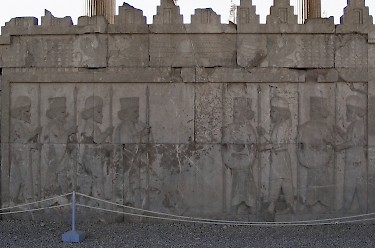
The central scene of the relief consists of eight soldiers, dressed like Medes and Persians. Between them is an empty space, and above them is a traditional representation of a winged sun, flanked by two sphinxes. It is not a very striking image and the truth is that the eight soldiers do not belong on this place. They replace an older relief.
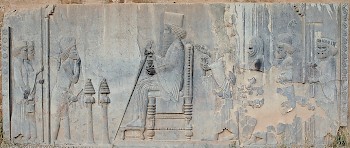
The rather damaged original consisted of the king and the crown prince receiving an official, who salutes them (proskynesis). The relief was found in the Treasury and it is not known why it was replaced. The same happened to the central relief of the northern stairs.
The original relief makes it possible to interpret the entire monument. What we see is the king, receiving representatives from the various nations in the Achaemenid Empire. Behind him are the crown prince, the aristocrats, and the most important courtiers (northern wall); in front of him is the mayor of the palace, who announces the arrival of the visitors (southern wall).
The eight soldiers belong to the regiment of "apple bearers" or Immortals. They are ready for battle, carrying a sword, spear, and shield. This is remarkable, because on other reliefs, we see soldiers dressed as civilians. The sphinxes in the upper register have the wings of an eagle, the body of a lion, the ears and tail of a bull, and the head of a man. One possible interpretation of this symbol (if an interpretation is needed) is that it represents freedom (the eagle's wings), power (the lion's body), strength (the bull), and intelligence (the human head).
Northern wall: courtiers
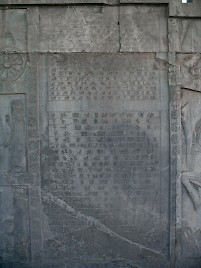
At the far ends of the relief are inscriptions with fairly stereotypical texts by king Xerxes (known as XPb). In the south, the text is in Old Persian, while the two northern texts are in Elamite and Babylonian.
A great god is Ahuramazda, who created this earth, who created that heaven, who created man, who created happiness for man, who made Xerxes king: the king of many kings, one ruler of many rulers.
I am Xerxes, the great king, king of kings, king of all nations, having various kinds of people, king in this great earth far and wide, the son of king Darius, an Achaemenid.
The great king Xerxes says: What has been done by me here, and what has been done by my father, all this was done by the grace of Ahuramazda. Me Ahuramazda and the other gods preserve me, my kingdom, and what has been done by me.
On the northern wall, we can see a large procession of dignitaries. Some of the dignitaries wear round caps that are usually identified as Median, while straight caps are identified as Persian. Closest to the king, the Persian dignitaries are walking; people with horses are next; at the end, we see two chariots. One may have been for the crown prince and the other for the king.note Another interpretation is that one chariot was the "sacred chariot of Zeus" (i.e., Ahuramazda) that is mentioned by the Greek researcher Herodotus of Halicarnassus.note
On four places, we can see the struggle between a bull and a lion. This is a very ancient Iranian motif, known from the fourth millennium BCE, and therefore belonging to the age before the invasion of the Indo-Iranians (the "Aryans"). It may represent, in a way we do not really understand, eternity. The same message is more or less implied in the representation of the sun.
It is an excellent theme for this place. The people who visited the Apadana offered tribute to the great king and received presents in return. This reciprocity strengthened the ties between the ruler and the subjects, and contributed to the continuation of the empire.
Southern wall: tribute bearers

The following pictures show the subject nations in the Achaemenid Empire, as they are depicted on the southern wall of the eastern stairs of the Apadana at Persepolis. The photos look a bit pale, but you must imagine that everything was once painted in bright colors.
Medes and Elamites
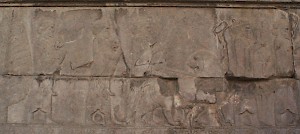
The first of the tribute bearers are Medes, which were related to the Persians. They are the first in the procession, suggesting that the Persians considered them their closest relatives. The Medes wear horseman's dresses and cloaks. Their turbans resemble the Turkish baslik; only the first Mede wears the typical round cap. Their presents are a pitcher, bowls, a sword (akinakes), rings, a cloak, a coat, and trousers.
The Elamites also lived in the center of the empire. Their capital Susa was the favorite residence of king Darius the Great. The tribute bearers are dressed in long Elamite cloaks that resemble modern Arab kaftans. The Elamites wear no turban; instead, they have wreaths in their curly hair. The Greeks called this a diadem, and accepted it as a sign of royalty. The Elamites offer the great king two bows, decorated with duck's heads, two daggers, a lioness, and two cubs. The lion was another symbol of royalty - and in fact, it still is the "king of the animals". The animal was probably sent to the king's hunting park, the paridaitha (enclosure) or "paradise". Note that the lioness that walks in front of the man, looks back to its cubs.
Armenians and Parthians
Like their neighbors, the Medes, the Armenians wear horseman's dresses and cloaks. Their tribute consists of a/o a bridled stallion, which more or less confirms the statement by the Greek geographer Strabo of Amasia that the Armenians paid 20,000 colts. The Armenians carry the other present for the king: a beautiful metal vessel with griffin handles. These objects have been found. The Armenian's turban resembles the Median headgear, although he has the cheek parts tied in his neck.
The Parthians are also dressed in a Median horseman's dress and cloaks, but they have a completely different turban, which is better suited to their country, close to the desert. It protects the face. The leader of the Parthian delegation almost hides himself in his cloak. The presents they offer are two bowls and a Bactrian (i.e. two-humped) camel. The last member of the delegation wears the skin of a feline. It may be a present, but is also possible that it is a rather unusual dress, which may or may not have some sort of ritual significance. The Arians (below) bring identical presents.
Babylonians and Lydians
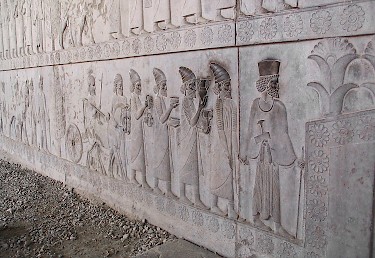
Below is the Babylonian embassy, wearing conical caps with odd tassels. In his Histories, the Greek researcher Herodotus of Halicarnassus tells us that Babylonia was very wealthy and paid an immense tribute - enough to pay a third of the Persian army. The Babylonians offer shallow bowls and a garment with a netted and tasseled border. The last man leads a humped bull. These are small presents, which seems to contradict the literary sources. On the other hand, the relief is a piece of art and not an account book.
The Lydian embassy is at the beginning of the lower register, suggesting the importance of their country. Their king Croesus, proverbially rich, had been defeated by Cyrus the Great in or after 547 BCE. The Lydian presents are two metal phials, two bowls, two beautifully decorated metal rings with griffins' heads, and a chariot, drawn by two stallions. The chariot seems to be a bit too small to be used in warfare, but this may, again, be the artist's liberty. The Lydians are dressed in long garments with horizontal stripes. They also have remarkable, conical hats that are not otherwise known. Their shoes are remarbably pointed.
Arians and Syrians
The Arians are dressed in short cloaks and trousers with turbans that protect them against the dust storms of the Kara Kum desert. Their presents are identical to those of the Parthians (above): two bowls and a Bactrian camel. Again, the last member of the delegation wears a feline's skin, although he is very damaged.
The Syrians are not entirely identical to the inhabitants of modern Syria. The real name of their satrapy was "across the river" (Euphrates), and it included what is now Lebanon and Israel/Palestine. In the days of Darius, the Syennesis (king) of Cilicia may have been a vazal of the satrap of Syria.
The Syrians have smooth cloaks, which leave the ankles visible, belts, and low shoes. On their heads, they wear wreaths. Their presents are two pair of bowls, a bar of copper in the shape of an animal skin, two beautiful rams, and a garment. The man to the left on the fourth photo offers the garment. It has four tassels and he may, therefore, be a Jew.note
Cappadocians, a hippopotamus, and Sacae
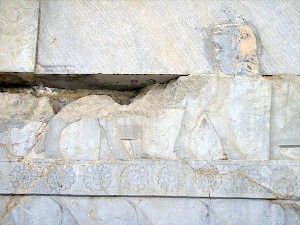
The people below are Cappadocians from central Turkey. Like their neighbors, the Armenians (above), they wear horseman's dresses and cloaks, which are closed with a Phrygian fibula, an undergarment, low shoes, and a turban. The turbans are tied. If they loosen the knot, they can cover their cheeks. Their presents are a bridled stallion, an overcoat, a coat, and trousers.
The Sacae offer the same presents. The Sacae or, to be more precise, Sakâ tigrakhaudâ ("nomads with pointed hats"), wear horseman's dresses, cloaks, and the pointed hats that the Greeks called tiara. Like the Cappadocians, they offer a horse (with a little bell), two decorated rings, an overcoat, a coat, and thight-like trousers.
Like all delegations, a courtier (in this case, a Mede) leads the first delegate by the hand towards the stairs, and the Apadana itself. The leader of the Sakâ is fully armed: he has a short sword (an akinakes) and a bow. It is likely that this group represents all nomad tribes of what is now Uzbekistan, including the Sakâ haumavargâ ("haoma-drinking namads"), the Apâ Sakâ ("Water nomads") or - as Herodotus of Halicarnassus calls them - Pausikoi, the Mâh-Sakâ ("Moon nomads") or Massagetes, the Dahâ, and the Sakâ paradrayâ ("nomads across the sea") from Ukraine.
Above the Sacae was a representation of Egyptian tribute bearers, but it is very damaged. The traces of a hippotamus can be discerned, though.
Greeks and Bactrians

The people below are Yaunâ or, as we would call them, Ionian Greeks. They are not represented as we - accustomed to Greek art - would have expected them, which is surprising because these reliefs are believed to have been made by Greek sculptors. Yet, these people wear no Greek dresses: instead they are dressed like Lydians (above). They also have a garment with striped sleeves and low shoes. Unlike their eastern neighbors, the Greeks have no coned hats.
The Greek presents are two ribbed metal cups, two pairs of shallow metal bowls, two sets of folded fabrics (perhaps blankets), and two pairs of convex cones that cannot be identified with any certainty. On the corresponding relief at the northern stairs of the Apadana, they are replaced by balls. However, the cones or balls are likely to have been hanks of threads, probably wool, because the sculptor uses the same gulflike pattern on the striped sleeve and the cones. This suggests that the cones are textiles too.
The Bactrians, who lived in northern Afghanistan and southern Uzbekistan, are easily recognizable because they are accompanied by a Bactrian camel (note the little bell). The other presents for the great king are two deep and two shallow bowls.
The Bactrians are dressed like Median cavalry men, but their trousers are different. They also have wreaths in their hair, which is tied in a knot. The Bactrians also have earrings, which is unusual. The only people with these jewelry are Bactrians, Arachosians (below) and very important court officials like the mayor of the palace. This may or may not indicate that the Bactrians had a special position in the Achaemenid empire, as the apanage of the crown prince (mathišta).
Gandarans and Arachosians
The people below are probably Gandarans, or, alternatively, Gandarans and Sattagydians - the problem is that the location of Sattagydia ("land of hundred cows") is unclear. However, they certainly lived in the far east, near the Gandarans, who lived in the valley of the river Cophen.
Their tribute consists of a buffalo, five lances, and a shield. These weapons are probably just ornamental, because the real power of the armies of the Punjab was the archery. The people are dressed in short, armless tunics and capes.
The Arachosians (and Drangians?) lived in the valleys of the rivers Helmand and Tarnak in southern Afghanistan, which means that they were separated from the Bactrians (above) by the Hindu Kush mountains - high but not a real barrier. They may have been ethnically identical, which may or may not explain their similar trousers and earrings. Like the Bactrians, the Arachosians have no turban but a wreath. Notice the tassel. Their presents are identical to those of the Bactrians: a camel, two deep and two shallow bowls.
Sagartians and Sogdians
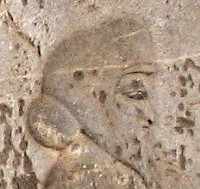
The Sagartians, who probably lived in the area of modern Yazd, wear a horseman's dress and cloaks. They were famous horsemen, fighting with lassoes. Their presents are garments and a bridled stallion. They are dressed like Medes and Armenians. Their turban is used to protect their faces, which reminds one of the fact that Yazd is an oasis in the desert.
The relief that showed the Sogdians, who lived in Central Uzbekistan, is badly damaged. Yet it is clear that they brought the great king a sword (akinakes), a pair of oblong rings, a pair of battle axes, and a bridled stallion. The relief shows that they wore some kind of tight-fitting cap.
Indians and Thracians
The southernmost apart of the stairs contains six smaller reliefs, dedicated to people on the periphery of the Achaemenid Empire. Below, you can see a man from the Indus valley (Sindhu) carrying gold (second photo). The ancients told lots of tall stories about the proverbial wealth of the Punjab. The Greek researcher Herodotus of Halicarnassus tells one of the most remarkable ones (text), which - no doubt - he had heard from a Persian spokesman. Next to this Indian was one of his compatriots, with a buffalo.
Next are the Thracians, from what is now Bulgaria and north-eastern Greece. One of Darius' generals subdued them in ca. 514 BCE, which offers a terminus post quem for this part of the relief. Together with the Macedonians, the Thracians were the only European nations that belonged to the Persian empire. Their tribute consists of two pairs of spears, two round (wicker?) shields, and a stallion. The Thracian caps, made of felt, are also known from Greek representations. The Thracians are dressed in chitons, a garment well-known from Greece.
Arabs and Carians
The Arabs, who wear no caps, were never completely subdued by the Persians, but those living near Gaza paid tribute to king Cambyses. They bring a garment with tassels and a dromedary. Unfortunately, the relief is damaged.
The Carians lived in the southwest of modern Turkey, and were believed to have invented the round shield (hoplon), which they offer the king, together with a spear and a bull. Although the Carians were known to the Persians as "cocks" because of the crests on their helmets, this man has a wreath in his head. They are otherwise dressed like Lydians (above).
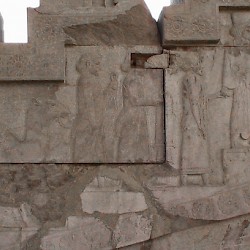 Persepolis, Apadana, East Stairs, Southern part, Arabs |
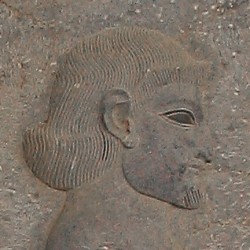 Persepolis, Apadana, East Stairs, Arab |
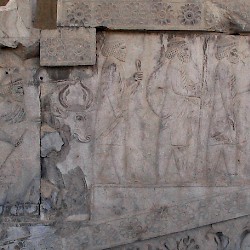 Persepolis, Apadana, East Stairs, Southern part, Carians |
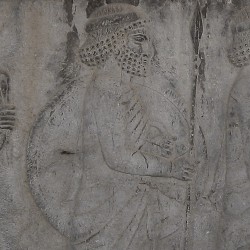 Persepolis, Apadana, East Stairs, Carian |
Libyans and Nubians
The Libyans, without caps, bring an oryx and a chariot. This relief is too damaged to say more about their dress. They may be Nasamones or belong to another tribe of the Libyan desert.
Finally, beautifully carved Nubians with an elephant's tusk. To the left, an okapi. A third man brings the king a small bowl with a lid.
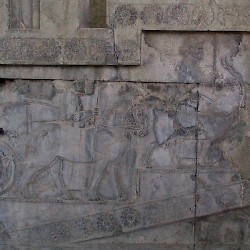 Persepolis, Apadana, East Stairs, Southern part, Libyans |
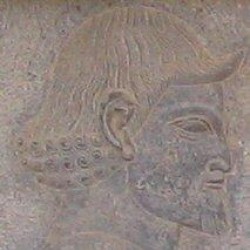 Persepolis, Apadana, East Stairs, Libyan |
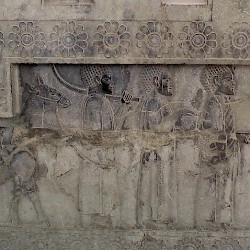 Persepolis, Apadana, East Stairs, Southern part, Nubians |
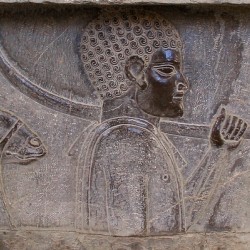 Persepolis, Apadana, East Stairs, Nubian |
Two elements are striking. In the first place, the nations of the west (Greeks, Carians, Arabs, Libyans, and Nubians) are all shown without caps or turbans. Perhaps, this struck the Persians as odd. In the second place, the conquered nations are shown as bringers of tribute, walking hand in hand with their masters. This is quite different from the Egyptian, Assyrian, and Roman representations of empire, which show the subjects as POWs.

